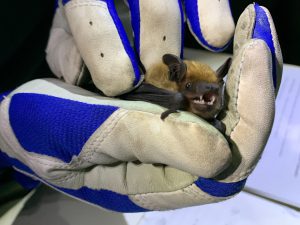Fishers Peak State Park, southeast of the town of Trinidad, opened to the public on October 30, 2020. It is home to Fishers Peak at 9,633 feet (2,936 m), the highest point east of its longitude in the United States. In 2017, the City of Trinidad began discussions about transferring 19,200 acres known as the Crazy French Ranch to public ownership.

The Ranch was purchased in February 2019 and officially became Fishers Peak State Park in October of 2020. Project partners included The Trust for Public Land (TPL), The Nature Conservancy (TNC), Great Outdoors Colorado (GOCO), Colorado Parks and Wildlife (CPW) and the City of Trinidad.

The Colorado Natural Heritage Program in collaboration with the partners conducted a survey to document the biodiversity, sensitive natural heritage resources, and most important areas for conservation at the park. The data from these studies provide the essential foundation for biodiversity conservation as a key pillar of master planning for the new park, balancing conservation and recreation. Results of these surveys show a diversity of plants, animals, and landscapes that attest to its importance as a refuge for biodiversity conservation.
Click a link below for details.
Botanical Surveys
Botanical surveys documented 454 different plant species in the park, thirteen of which are rare species tracked by the Colorado Natural Heritage Program with seven of them considered endemic to the Colorado and/or New Mexico. Areas containing mature forests of white fir, (Abies concolor), pinyon pine (Pinus edulis), Douglas-fir (Pseudotsuga menziesii var. glauca) and juniper (Juniperus monosperma, J. scopulorum) offered habitats for some of the rarest species. One of the rarest species documented at the park was found along the cliffs. It is a member of the mustard family (Brassicaceae) and is known as Smith’s draba (Draba smithii). The entire distribution for this species includes only a few counties in Colorado and one county in New Mexico. Another rare plant species, the Canadian River spiny aster (Herrickia horrida), is known only from northern New Mexico and Las Animas County and was documented in the steep canyons of the park. The large grasslands on the mesa tops are dominated by Parry’s oatgrass. This type of grassland is only known from Colorado and Wyoming. In Colorado it is uncommon to see large undisturbed Parry’s oatgrass grasslands. At Fishers Peak State Park, these grasslands were home to rare plant species including the Marsh-meadow Indian-paintbrush (Castilleja lineata) and a rare sedge species known as grassyslope sedge (Carex oreocharis). In Colorado, the Marsh-meadow Indian-paintbrush is only known from a few counties along the New Mexico State line and grassyslope sedge is uncommon along the Front Range.



Below the cliffs are forests, woodlands and shrublands. These areas also include small streams, ponds, springs and wetland habitats. Scattered throughout the park are open meadows each with their own characteristic grasses and forbs. The areas with a mature forest overstory support a number of rare plant species that were documented during this survey. These forests and woodlands exhibit important functions that differ from younger forests and these characteristics shape the local environment, providing a greater variety of habitats, greater access to some important nutrients, greater soil drainage and aeration, and other benefits.



Zoological Surveys
There were 186 animal species documented during the 2019-2020 survey of Fishers Peak State Park: 83 insects including 76 butterflies and two odonates, 71 birds, 15 mammals, 10 mollusks, four reptiles, and one amphibian. There were 12 wildlife species that are considered elements of conservation concern by the Colorado Natural Heritage Program.
The wildlife species of highest conservation priority documented by the Colorado Natural Heritage Program at Fishers Peak State Park is the New Mexico meadow jumping mouse. Declines in New Mexico jumping mice populations have occurred due to cumulative habitat loss and fragmentation across the range of the subspecies. The New Mexico meadow jumping mouse inhabits densely vegetated riparian areas along streams in southern Colorado into central New Mexico.

Another rare wildlife species present at Fishers Peak State Park is the Peregrine Falcon. There are approximately 70 breeding pairs of Peregrine Falcons in Colorado (Colorado Bird Atlas Partnership 2016) and Breeding Bird Survey data indicate the falcon has increased 15% per year within Colorado since 1966 (Sauer et al. 2017). The presence of 76 butterfly species on one property shows that the park contains important butterfly habitat. Surveys documented two imperiled species of butterfly: the wetona hobomok skipper subspecies (Lon hobomok wetona) and the mountain checkered-skipper (Pyrgus xanthus). The habitat of these two species is subject to widespread alteration through grazing, forestry management and recreational development. Both species are threatened by the closure of forest openings due to long-term fire suppression and the invasion of exotic plants displacing host plants. There is a diverse bat community at Fishers Peak State Park with seven species verified by CNHP researchers. The bat community is supported by good quality forest habitat available for foraging and roosting as well as the cliff habitat and boulder fields, which also supply roosting sites for bats. Roost availability and abundance are critical elements that can limit bat populations. The rarest species present were the hoary bat (Lasiurus cinereus) and silver-haired bat (Lasionycteris noctivagans), each of which is considered vulnerable both globally and within Colorado.



The mollusk community occupying the water resources of Fishers Peak State Park is impressive. A total of 10 species of mollusks were recorded from the park including a state rare mollusk tracked by the Colorado Natural Heritage Program, swamp lymnaea (Lymnaea stagnalis). The swamp lymnaea is demonstrably secure globally, but rare in Colorado . Freshwater snails are among the most imperiled groups of organisms in the world.

from Wikimedia Commons




